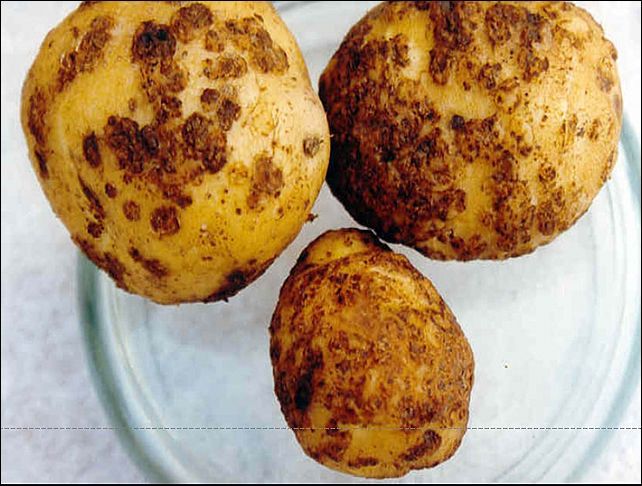 Potato is a disease-prone crop. Potato diseases can develop due to exposure to viruses, fungi, bacteria, nematodes. Planting material can be infected if storage conditions are not observed, neglect of the need to disinfect improvised material, use of unripe humus, non-compliance with agricultural technology and agricultural technology for growing potatoes.
Potato is a disease-prone crop. Potato diseases can develop due to exposure to viruses, fungi, bacteria, nematodes. Planting material can be infected if storage conditions are not observed, neglect of the need to disinfect improvised material, use of unripe humus, non-compliance with agricultural technology and agricultural technology for growing potatoes.
Growing potatoes is a laborious process. In order not to remain without a crop in the fall, it is important to be able to determine the presence of crop diseases in the early stages and take measures to combat them. No less important are preventive measures to maintain the health of the potato itself and the soil in which it is grown.
Content
Description of the causes of disease
| Disease | Pathogen | Propagation mechanism and features |
|
Late blight
|
Phytophthora mushroom. White spores are usually located on the bottom of the foliage.
|
Spores can fly long distances, affecting plants. Favorable weather for late blight: wet, rainy, temperature up to 25 ° C. |
|
Black scab
|
Rhizoctonia solani J.G. Kuhn (stage of mycelium). Thanatephorus cucumeris (A.B. Frank) Donk (sexual stage of the fungus). |
Mycelium and fungus sclerotia persist on tubers and in the soil. The disease often progresses on loamy soils with acidity from 5.5 to 6.5 pH at a temperature of about 17 ° C and a relative humidity of 65%. |
|
Silver scab
|
Helminthosporium solani Durieu et Mont. The mycelium is located in the peel of the tubers. The hue is at first light, in the process of development it becomes brown. |
The fungus spreads immobile spores at high humidity and temperature. More often on light soils. The causative agent can be found on tubers during their formation or during harvest in the fall. |
|
Powdery scab
|
The pseudo-fungus Spongospora subterranea (amoeboid without shell). |
The fungus infects the tubers, parasitizing in their cells. Distributed by disputes. The affected tuber can be distinguished by tubercles filled with spores. When the tubercle bursts, a cavity will remain in the tuber, and the ripened amoeboids will move in the soil, infecting new tubers. The main condition for the spread: waterlogged soil. In adverse conditions, the pseudo-fungus is coated and is at rest. |
|
Potato cancer
|
Synchytrium endobioticum (Schilb.) Perc. |
The fungus does not affect only the roots of potatoes. Propagated by spores contained in the growing tissues of the plant. Spores can spread through garden tools, water, plant debris. It remains in the ground for up to 30 years.
|
|
Alternariosis
|
Mushroom genus Alternaria. |
The source of infection is mycelium, which remains on plant debris, as well as small spores that are carried by the wind and penetrate into the plant tissue through the epidermis. Leaves, stems, less often potato tubers are affected. Early development is asymptomatic, manifests itself during the period of budding, flowering culture. Black circles or triangles can be seen on the plant. On the tubers there are dark slightly depressed spots with clear boundaries. Factors of the development of the disease: - dry weather; - t> 25 ° C; - lack of potassium and nitrogen in the soil; - excess phosphorus in the soil. Alternariosis often affects the seed material infected with viruses and rhizoctonia. |
|
Macrosporiosis
|
Macrosporium solani and alternaria solani | Infection of plants with spores occurs through the stomata and damage to the epidermis of the leaves. |
|
Blackleg
|
Pectobacterium. |
Mushrooms live in the upper layers of the soil, feeding on dead plant tissues. In contact with the root neck and roots, they affect the culture. Pectobacterium can persist in seed tubers. Pectobacterium is spread by aphids, Colorado potato beetles, wireworms, cicadas. From stems through stolons, bacteria enter the tubers, causing a process of softening and decay. Propagation conditions: high humidity, t = 21-26 ° C. |
|
Ring rot
|
Corynebacterium sepedonicum. |
The pathogen from infected tubers moves to the aerial part of the plant and clogs the vessels. It can be transmitted through non-disinfected tools, knives. It develops with high humidity and moderate temperature. |
|
Brown rot
|
Bacteria Ralstonia solanacearum. |
The source of infection is soil. Bacteria penetrate the tubers through the stolons, stomata, various injuries on the stems and roots. Propagating, bacteria fill the blood vessels of the plant with brown mucus. Foliage withers. It develops at temperatures> 27 ° C and high humidity. |
|
Verticillus wilting
|
Soil fungi Verticillium albo-atrum Reinke et Berthold. |
It appears at the end of flowering plants. The pathogen enters the plant, spreads through the conducting bundles of xylem, where the development of the mycelium occurs. On the cross sections of the stems brown spots are noticeable. It progresses at a temperature of 21-24 ° C in humid conditions. |
|
Fusarium wilting or dry rot
|
Fusarium oxysporum Schl. |
It can appear at any time during the growth of potatoes, more often during the flowering period. Mycelium penetrates the plant, develops in the conductive system. If you cut the stem, brown vessels or vascular rings will be noticeable. The stored crop is affected from the stolonous part when spores enter. During the growth of mycelium, the peel of the potato shrinks, becomes rotten, depressed. Sporulation appears in the form of bright convex pads. The disease develops very quickly if the plant has mechanical damage, is corrupted by wireworms. Favorable conditions for dry rot: high soil moisture and hot weather. |
|
Anthracnose (dartosis)
|
Colletotrichum atramentarium Berk, et Broome. On the affected surface, a pathogen is formed earlier. Outwardly, it looks like small black bristly pads. Condias and conditioners are small, uncolored, with sclerotic compaction. Sclerotia with a pathogen are located singly or in groups.
|
Especially often anthracnose through the soil (the main source) affects the culture of early ripe varieties in the second half of the growing season. Tubers can be infected during storage or harvesting. Spores can be spread by insects, wind, water during irrigation. The fungus spreads through the stolon end. A dark spot appears on the tuber, then sclerotia increases in number, and the tuber becomes soft, smells bad. Favorable weather conditions: dry, hot (t> 22 ° C), acidic soil with a lack of phosphorus. |
Potato diseases and control
When dealing with potato diseases, it is important to follow the recommendations and not use toxic chemicals hazardous to health.
Fungal diseases
- Late blight
Brown spots appear on the leaves on top, white plaque from the spores below. Foliage dies and falls. On tubers, the spots are first gray, then gray-brown.
The introduction of double doses of fertilizers containing potassium, phosphorus is recommended.
Fungicide Treatment:
- during the closure of the tops twice with the preparations “Ridomil MTs” / “Oksikhom”;
- after flowering with copper chloride / Kuproksat;
- during tuberization twice with the drug "Alufit".
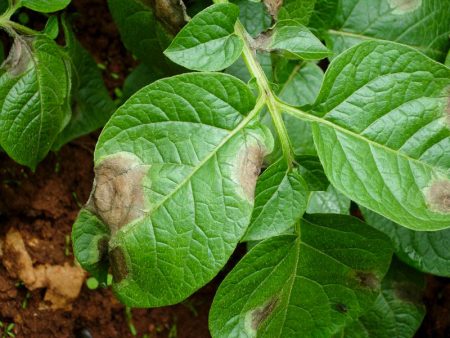
- Black scab
On tubers, the scab has the appearance of black sclerotia, reticular necrosis or pitted spotting. Brown ulcers, dry rot appear on the stems. The bushes are often stunted, foliage curls from the edges to the center.
Chemical methods of control:
- Single tillage when planting potatoes with the Quadrice preparation. Consumption up to 200 liters per 1 ha;
- processing of seed potatoes with the drug "Maxim".
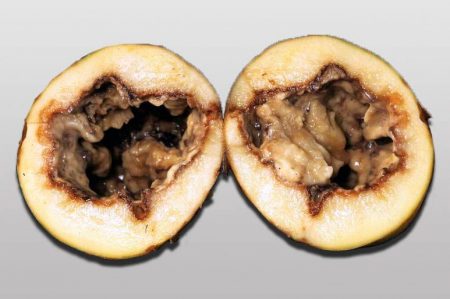
- Silver scab
The lesion has the appearance of spots of various sizes without gloss.
If infected potatoes are left in storage, the silver scab will hit the entire crop by spring. At this point, the spots on the tubers will acquire a metallic luster, and the peel will wrinkle.
To cultivate the soil when planting tubers, it is recommended to try on the Azoxystrobin preparation. Single treatment, consumption up to two hundred liters per 1 ha.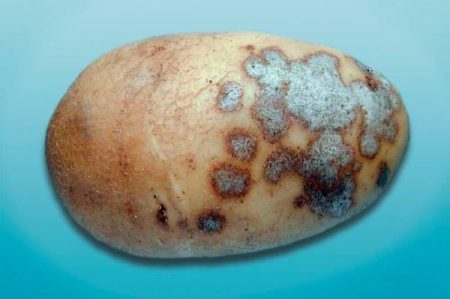
- Powdery scab
Potatoes affected by scab look and are poorly stored. “Warts” (pustules) grow on the surface, which after a while dry out and crack. A dry mass spills out from the pustules - spores interspersed with the destroyed tissue of the potato. On the roots, white growths can be seen, further darkening.
Severely affected tubers should not be eaten. On contaminated soil, do not plant potatoes up to 7 years.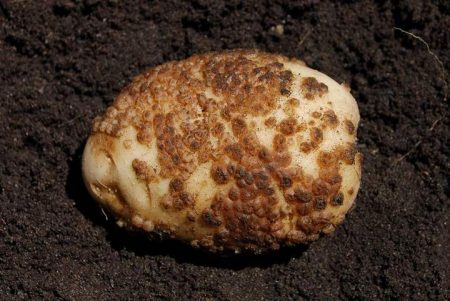
- Potato cancer
Quarantine is a dangerous disease.
A cancer patient has numerous growths of different sizes. On tubers, the growths are first white, then they darken and rot. On stems and leaves, growths are greenish.
Chemical treatment of soil with chloropicrin is carried out by a special quarantine inspection. All plants are burned immediately.
Variety resistant disease:
- Spark;
- Early Belarusian;
- Detskoselsky;
- Pavlinka;
- Candidate;
- Dining room;
- Gatchinsky.
Even when growing cancer-resistant varieties, it’s important to maintain crop rotation.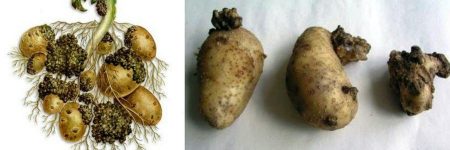
- Alternariosis
The most resistant varieties of potatoes:
- Volzhanin;
- Snow White;
- Fairy tale;
- Resource;
- Lina;
- Bryansk delicacy;
- Bronnitsky.
Chemical treatment to control the pathogen is carried out according to the following scheme:
- at the first manifestations (dry brown spots on the leaves, yellowing and dying of leaves, almost black spots on the stems) or during the growing season, spraying with Ridomil Gold MC (solution 0.5%, consumption 2.5 kg / ha) or Folman "(Consumption 3 kg / ha);
- during the formation of tubers, three times spraying with the Bravo KS preparation (consumption 3 l / ha) with an interval of 10 days.
To avoid the appearance of the disease, it is necessary to properly harvest the crop (without damaging the skin) in the fall and after that deeply plow the soil.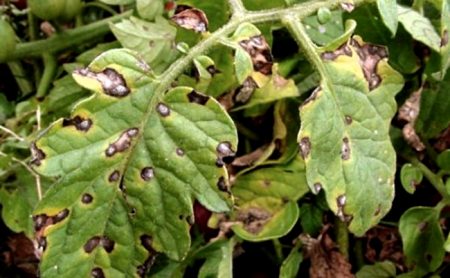
For harvesting, only fully ripened tubers are suitable, the affected ones must be discarded immediately. After harvesting, the crop should be kept at room temperature and high humidity for 21 days.
- Macrosporiosis
The spots are small, grayish-brown, with concentric circles. Located on the top of the sheet.
It is recommended to spray potato bushes with Bordeaux liquid, solution 1%, consumption up to 6 liters per hundred parts. It is necessary to make increased dosha of potash fertilizers.
Viral diseases
| Disease | Manifestations |
|
Striped mosaic
|
Dark spots on the leaves of potatoes. Mosaic view, located on the bottom of the foliage. Subsequently, black dots appear on the leaves of the potato. The turgor disappears, the leaves fade, fall off. |
|
Wrinkled mosaic
|
Corrugated sheets, wrinkled. |
|
Viral mosaic
|
The disease is caused by several viruses at once. Light spots appear on the foliage, which darken over time. |
|
Leaf curl
|
It is observed when the culture is affected by the virus M or L. In the first case, the leaves curl upward, in the second - along the central vein. |
|
Mottling
|
X-virus (PVX) is the causative agent of mottling. The virus is transmitted by the fungus Synchitrium endobioticum. Light mottled spots appear on the leaves. If the strain is strong, the tissue dies. |
|
Gothic tubers or spindle-shaped
|
The causative agent is the Potato Spindle Tuber Viroid RNA molecule - PSTVd. The foliage of diseased plants is narrow, small, moving away from the stem at an acute angle. The bushes are elongated, lagging behind in growth. Tubers are underdeveloped, small, with pronounced lentils. The shape of the tubers is pear-shaped or very elongated. |
Bacterial diseases
- Blackleg
The foliage of diseased plants dries, twists into a tube. Potato stalks soften and rot, can break off. The plant is easy to tear from the soil. In water, mucus is secreted from a section of the stem. The skin of the tubers cracks, darkens.
Infected bushes must be destroyed in one of two ways:
- to burn;
- bury to a depth of more than 100 cm, covered with bleach.
The disease can occur latently. It is important to observe crop rotation, use healthy seed potatoes and process them before planting, to fertilize for normal crop growth.
- Ring rot
The diseased plant can be distinguished by fading whitening leaves, stems (fall to the ground) and rotten rings inside the tubers. In water, a whitish or light yellow mucus is secreted from a section of the stem.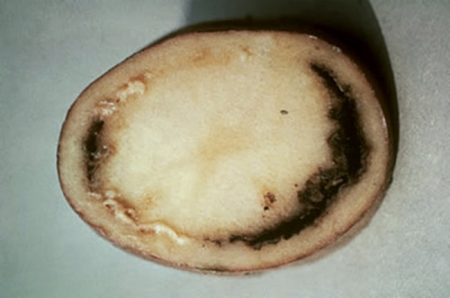
Affected bushes need to be dug up and burned with tubers. The tops must be mowed and harvested 3 weeks before harvesting the potatoes. Instrumentation to disinfect. It is important to carry out preplant planting of seed material and soil. When germinating in the light, tubers affected by bacteriosis can be detected.
- Brown rot
This disease is quarantine. The main way to detect bacterial rot is simple: the stem is cut and placed in water, as a result, brown exudate begins to stand out. On the section of tubers, spots of white mucus or brown rotten circles can be seen. Bacterial mucus may be released from the stolon trail and eyes.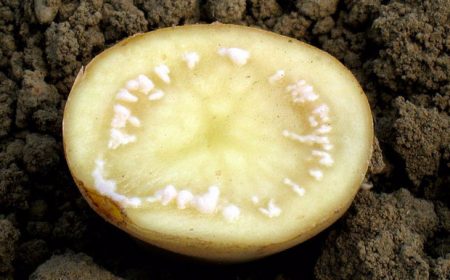
Bacteriosis resistant varieties:
- Luck;
- Resource;
- Ulyanovsk;
- Volzhanin.
Sick bushes need to be dug up and burned as accurately as possible. Before harvesting (for 2-3 weeks), be sure to mow and harvest the tops.
At the place where the infected potatoes grew, it is worth planting beets or wheat. Repeated planting of potatoes in the same area is permissible no earlier than after 3-5 years.
Chemical methods for controlling bacterial rot are not effective.
On a note! It is recommended to etch planting material with TMTD or Planriz.
Other diseases
- Verticillus wilting
This disease can be distinguished by the following signs:
- foliage begins to turn yellow, dry and curl (usually development progresses along the bush from bottom to top);
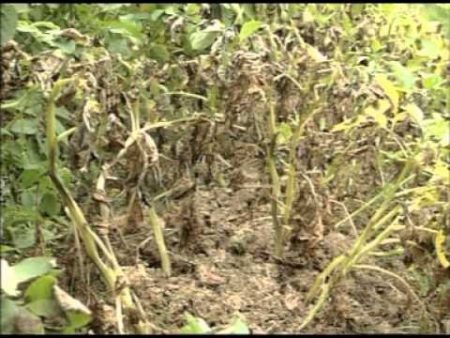
- in the heat of the leaves quickly fade, and then curls;
- eyes rot on the tubers, recesses remain instead;
- on diseased leaves and stems, a pink or gray coating;
- potato sprouts twist and die.
The pathogen is stored for a long time in the soil and tubers, so it is so important to carry out the processing and rejection of seed material before sowing. The disease can be transmitted through the root system to mechanically damaged bushes, it is advisable to carefully carry out loosening and weeding the field.
Potato bushes with signs of wilting should be carefully dug up and burned together with tubers.
Spraying is carried out with solutions of the following drugs in a concentration of 0.2:
- Topsin-M;
- Previkur;
- "Fundazole";
- Benlat.
- Fusarium wilt
The most resistant varieties to this disease: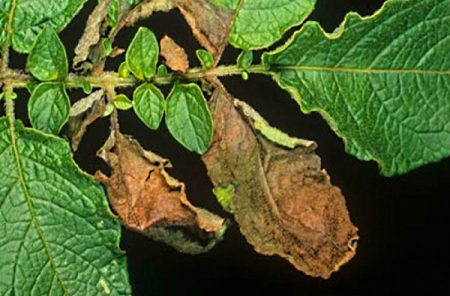
- Detskoselsky;
- Berlichingen;
- Priekulsky early.
Infected plants can be easily identified by yellowing, rotting with a pink coating on the leaves.Fusarium wilting is "treated" mechanically by destroying infected bushes. The plant must be removed with a lump of earth and burned. Shoes and tools must be disinfected.
After rejection, the remaining plants must be sprayed with a solution of potassium permanganate, sprinkle the soil with powder sulfur and ash.
It is highly effective liming the soil with dolomite flour or chalk. Mulching the soil greatly reduces the activity of the pathogen.
Drugs against the disease:
- "Agat-25K";
- Fitosporin-M;
- Bactofit;
- "Fundazole";
- Topsin-M;
- "Maxim" (for pickling planting material).
- Anthracnose
On the leaves, spots of a reddish-brown hue, darker or yellowish along the edge, gradually grow. Tops die off in plants, tubers during storage and rot during the growing season.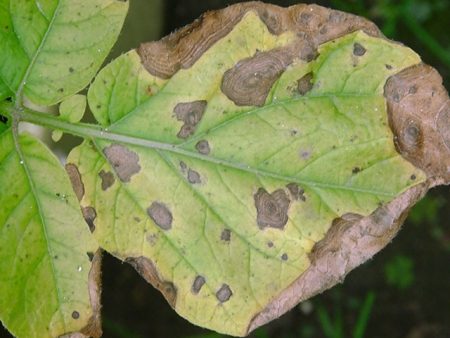
It is necessary to destroy all infected plants, to carry out the disinfection of vegetable stores and tools.
Effective drugs:
- Previkur;
- "Speed";
- "Fundazole";
- "Acrobat MC";
- Fitosporin-M.
Permissible use of copper oxychloride. Processing is carried out three times with an interval of 7-10 days, following the instructions on the package. Drugs can be alternated for greater effectiveness.
Potatoes in the same area can be planted after 4 years. Be sure to remove weeds and plant debris from the soil. Soil in the fall must be dug up without loosening.
Prevention and processing of potatoes before planting from diseases
Processing technology
Step 1. Tubers 1 month before planting are removed from the storage, manually sorted and rejected by size, weight. Choose healthy tubers without signs of disease, rot.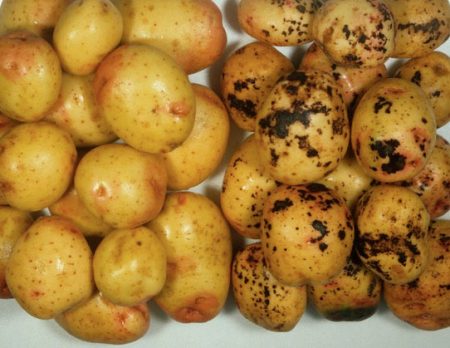
Step 2 Tubers are stacked in boxes or on shelves in 2-3 layers.
Step 3 Boxes are placed in a bright place with a temperature of 17-20 ° C. Periodically, the tubers are turned over, waiting for the emergence of sprouts.
Step 4 The tubers are treated with insectofungicidal preparations:
- "Maxim" per 1 liter of water 20 ml of the drug. For 100 kg of tubers, up to 10 liters of solution will be needed;
- "Prestige". In 5 l of water, 100 ml of the drug. This solution is enough to spray 100 kg of potatoes. The suspension should be applied to three quarters of the tuber. For early varieties of potatoes is not applicable;
- "Cruiser." Consumption - 70 ml per 100 kg of potatoes.
Mandatory crop rotation. It is advisable to change the place of growing potatoes every 3 years. It is not recommended to grow potatoes in lowlands and on heavy soils. Before harvesting, it is worth mowing the tops, and after harvesting, completely remove plant residues from the field, and then carry out a deep digging. Harvest potatoes only in dry weather.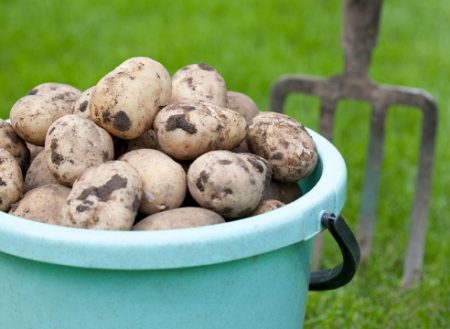
Watering should be moderate so that the soil does not dry out or become waterlogged. It is not recommended to pour potatoes with ice water in the heat, to spray drops on the foliage. After watering, you need to carefully loosen the soil.
Potato storage should be carefully prepared:
- cleared;
- the walls are painted with freshly slaked lime;
- the premises are disinfected with a 3% solution of copper sulfate;
- adequate ventilation is provided.
Reviews
Alexander B.
I have been using the drug "Maxim" for more than three years and I'm not going to change it. The tool is universal, I am very pleased with its action. I use when planting potatoes, I spray the crop before storage. Very economical. The main plus is that potatoes after processing are not dangerous for ingestion.
Maria S.
My favorite remedy is Fitosporin M. This is not just fungicide, but bio. It fights well with fungi, late blight. I take the preparation in the form of a paste (I like it better) and water the soil before planting. The potato grows healthy, large. There has never been a black leg.




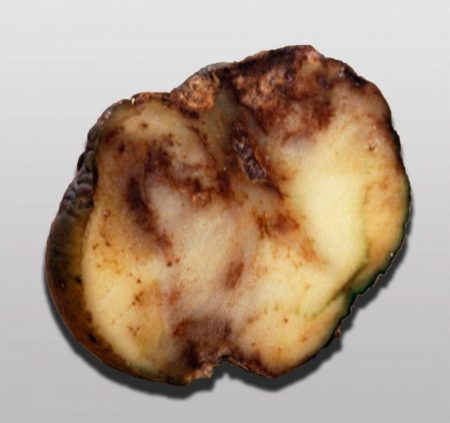
 Description and description of varieties in Belarus with a photo
Description and description of varieties in Belarus with a photo Do I need to pick flowers from potatoes: why do they do it
Do I need to pick flowers from potatoes: why do they do it When to dig potatoes: timing and availability of new potatoes
When to dig potatoes: timing and availability of new potatoes How to grow a good potato crop: various methods and methods, planting and care
How to grow a good potato crop: various methods and methods, planting and care